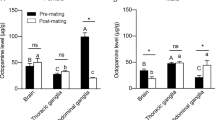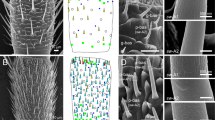Abstract
Insects, including cockroaches, have the ability to select a proper diet from different nutrient choices. We have showed previously that various neurotransmitters and neuromodulators appear to regulate certain aspects of feeding in the cockroach, Rhyparobia madera. In the current study, we examined the role of octopamine in feeding behavior of cockroach nymphs. By either injection or direct incorporation into the diet blocks, an octopamine agonist (octopamine or synephrine) or antagonist (phentolamine) was effective in altering feeding in R. madera nymphs. Both octopamine and synephrine increased feeding slightly, while phentolamine decreased feeding dramatically. Phentolamine was able to decrease feeding, but not motor activity, when injected directly into the nymphs. Octopamine appears to cause increased feeding in the cockroach.
Similar content being viewed by others
REFERENCES
Abisgold, J. D., and Simpson, S. J. (1998). The effect of dietary protein levels and haemolymph composition on the sensitivity of the maxillary palp chemoreceptors of locusts. J. Exp. Biol. 135: 215–22. Octopamine's Influence on Insect Feeding Behavior 49
Ahmad, I., Waldbauer, G. P., and Friedman, S. (1993). Maxillectomy does not disrupt selfselection by larvae of Manduca sexta (Lepidoptera: Sphingidae). Ann. Entomol. Soc. Am. 86: 458–463.
Angioy, A. M., Tomassini Barbarossa, I., Crnjar, R., and Liscia, A. (1989). Effects of octopaminergic substances on the labellar lobe spreading response in the blowfly Protophormia terraenovae. Neurosci. Lett. 103: 103–107.
Bernays, E. A., and Bright, K. L. (1993). Mechanisms of dietary mixing in grasshoppers: A review. Comp. Biochem. Physiol. 104A: 125–131.
Blundell, J. E. (1986). Serotonin manipulations and the structure of feeding behaviour. Appetite 7: 39–56.
Cohen, R. W. (2001). Diet balancing in the cockroach, Rhyparobia madera: Does serotonin regulate this behavior? J. Insect Behav. 14: 99–111.
Cohen, R.W., Heydon, S. L., Friedman, S., and Waldbauer, G. P. (1987). Nutrient self-selection by the omnivorous cockroach, Supella longipalpa. J. Insect Physiol. 33: 77–82.
Cohen, R. W., Friedman, S., and Waldbauer, G. P. (1988). Physiological control of nutrient self-selection in Heliothis zea larvae: The role of serotonin. J. Insect Physiol. 34: 935–940.
Evans, P. D. (1985). Octopamine. In Kerkut, G. A., and Gilbert, L. (eds.), Comprehensive Insect Biochemistry, Physiology and Pharmacology, Pergamon Press, Oxford, pp. 499–530.
Fields, P. E., and Woodring, J. P. (1991). Octopamine mobilization of lipids and carbohydrates in the house cricket, Acheta domesticus. J. Insect Physiol. 3: 193–199.
Friedman, S., Waldbauer, G. P., Eertmoed, J. E., Naeem, M., and Ghent, A. W. (1991). Blood trehalose levels have a role in the control of dietary self-selection by Heliothis zea larvae. J. Insect Physiol. 37: 919–928.
Howell, K. M., and Evans, P.D. (1998).The characterization of presynaptic octopamine receptors modulating octopamine release from an identified neurone in the locust. J. Exp. Biol. 201: 2053–2060.
Konings, P. N. M., Vullings, H. G. B., van Gemert, W. M. J. B., De Leeuw, R., Diederen, J. H. B., and Jansen, W. F. (1989). Octopamine-binding sites in the brain of Locusta migratoria. J. Insect Physiol. 35: 519–524.
Leibowitz, S. F., and Stanley, B. G. (1986). Neurochemical controls of appetite. In Rolls, E. T. (ed.), Feeding Behavior: Neural and Humoral Controls, Academic Press; New York, pp. 191–234.
Long, T. F., and Murdock, L. L. (1983). Stimulation of blowfly feeding behavior by octopaminergic drugs. Proc. Natl. Acad. Sci. USA 80: 4159–4163.
Nathanson, J. A. (1989). Development of a photoaffinity ligand for octopamine. Mol. Pharmacol. 36: 34–43.
Ramirez, J.-M., and Pearson, K. G. (1990a). Local anesthetic action of phentolamine on insect mechanoreceptors. J. Comp. Physiol. A 167: 475–483.
Ramirez, J.-M., and Pearson, K.G. (1990b). Chemical deafferentation of the locust flight system by phentolamine. J. Comp. Physiol. A 167: 485–494.
Shafi, N., Midgley, J. M., Watson, D. G., and Smail, G. A. (1989). Analysis of biogenic amines in the brain of the american cockroach (Periplaneta americana) by gas chromatographynegative ion chemical ionisation mass spectrometry. J. Chromatogr. 490: 9–19.
Simpson, S. J., and Simpson, C. L. (1990). Mechanisms of nutritional compensation by phytophagous insects. In Bernays, E.A. (ed.), Plant Insect Interactions,CRCPress, Boca Raton, FL, Vol. II, pp. 111–160.
Simpson, S. J., James, S., Simmonds, M. S. J., and Blaney, W.M. (1991).Variation in chemosensilla and control of dietary selection behaviour in the locust. Appetite 17: 141–154.
Stevenson, P. A., and Spörhase-Eichmann, U. (1995). Localization of octopaminergic neurons in insects. Comp. Biochem. Physiol. 110A: 203–215.
Swales, L. S., and Evans, P. D. (1988). Histochemical localization of octopamine-and proctolinsensitive adenylate cyclase activity in a locust skeletal muscle. Histochemistry 90: 233–239.
Vehovsky, A., Elliott, C. J. H., and Elekes, K. (1998). Octopamine: A new feeding modulator in Lymnaea. Phil. Trans. Roy. Soc. Lond. 353: 1631–1643.
Waldbauer, G. P., and Friedman, S. (1991). Self-selection of optimal diets by insects. Annu. Rev. Entomol. 36: 43–63.
Wierenga, J. M., and Hollingworth, R. M. (1990). Octopamine uptake and metabolism in the insect nervous system. J. Neurochem. 54: 479–489.
Wurtman, R. J., and Wurtman, J. J. (1984). Nutrients, neurotransmitter synthesis, and the control of food intake. In Stunkard, A. J., and Stellar, E. (eds.), Eating and Its Disorders, Raven Press, New York, pp. 77–86.
Author information
Authors and Affiliations
Corresponding author
Rights and permissions
About this article
Cite this article
Cohen, R.W., Mahoney, D.A. & Can, H.D. Possible Regulation of Feeding Behavior in Cockroach Nymphs by the Neurotransmitter Octopamine. Journal of Insect Behavior 15, 37–50 (2002). https://doi.org/10.1023/A:1014428011892
Issue Date:
DOI: https://doi.org/10.1023/A:1014428011892




